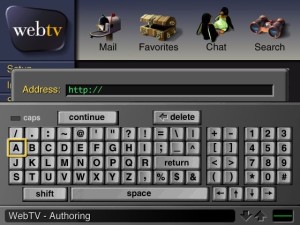Naturally, Microsoft contends that variations of Windows CE, the slimmed-down version of its flagship operating system, will be the best choice for the brains inside these devices. In fact, the new WebTV boxes have their own operating system with a bit of Windows CE running underneath. By doing this, Microsoft is encouraging software developers to write applications for its set tops, using Windows CE tools they already know. Small applications for the WebTV devices, as well as games and other home-oriented programs, are expected to ship this year.

It’s a long way from the latest version of WebTV to Microsoft Icebox OS 4.0. But while Microsoft and other companies wait for the Internet appliance market to develop, they’re quietly turning your home PC into something that looks more like a TV.
According to specifications proposed earlier this year by Intel, Microsoft, and Compaq–all of which have some clout in such matters–a year from now, most new home computers will have TV tuner cards that can receive digital television broadcasts. The companies say the tuner cards will add less than $50 to the price of a PC, and that cost will be absorbed in the normal erosion of PC pricing.
Microsoft is also adding TV-related features to its forthcoming Windows 98. Currently expected to ship in the second quarter of 1998, the operating system will have several new features that support “broadcast PC,” including the ability to receive data transmissions along with broadcast video and audio.
And just as Microsoft added its Internet Explorer browser to Windows 95, it will put “Television Explorer” in Windows 98, according to Pierre deVries, director of advanced TV projects at Microsoft. The operating system will be able to gather information from a variety of online television programming guides–cable, broadcast, and satellite–and display it in a single grid on screen. This TV guide will let you do things your trusty paper listings can’t: You’ll be able to search all the programs by, say, an actor’s name or a movie genre, and the guide may even help you program your VCR to record shows.
These new products will prepare your PC for upcoming changes to the material you see today both on TV and on the Web. The two types of content are invading each other’s turf.
It’s the Content, Stupid
Today, most of us have little use for a TV tuner card in our PC. But that may soon change. Intel, Microsoft, Compaq, and Lucent Technologies have been pressing broadcasters to begin developing new types of entertainment and educational programming–“content,” as they say in Silicon Valley–that blends video with interactive Web pages and electronic commerce. You’ve probably heard the standard examples: A football game where you can watch the game in one window while calling up player stats from a Web site in another; or an interactive version of Seinfeld that lets you chat with other fans online while watching the show.
But selling will be a big part of this story. In a particularly odious exam- ple, a screen might pop up saying, “Do you like Jerry’s shirt? Order it now for only $39.95.” Or:”Want to book an airline ticket to New York City to go on Kenny Kramer’s unofficial Seinfeld tour? Click here!” For the truly masochistic, new streaming video technologies will enable you to watch 30-minute infomercials embedded in Web pages, and even rewind them and play them back.
These new types of digital content can be viewed on either PCs or TVs. But this doesn’t mean that the Web sites you visit now will start looking like this week’s episode of E.R.: It’s more likely that E.R. will add Internet ele- ments.
WebTV, for example, is working with the producers of prime-time shows to create online content for owners of the new WebTV set-top boxes. A WebTV sub- scriber watching these shows will be able to use new picture-in-picture fea- tures to see the show and Web information at the same time–such as home pages for each show, with e-mail addresses for stars; trivia; and scheduled online chats. Some of this content will be ready when the new WebTV boxes ship in October; more will roll out during 1998. Television shows will feature Web content this year, and the Web will have some TV content, but the two will not fully merge anytime soon.
Why not? For one thing, TVs and PCs will continue to occupy different rooms in many homes, says Mark R. Anderson, president of Technology Alliance Partners, which publishes the Strategic News Service in Friday Harbor, Washington. The “killer” digital TV applications will play on television’s strengths–for example, taking Discovery Channe-type programs and making them more realistic and more interactive. Officials at Microsoft concur with the room theory. For detailed tasks that require your nose to be 18 inches from the screen, the computer is a better tool. For family or group viewing from a distance of 10 or more feet, the TV set is the right appliance.
The New Bandwidth
The remaining stumbling block is, of course, bandwidth. It’s far easier to add small Internet elements to the broadband cable and satellite networks than to add huge amounts of video data to thin PC Internet connections. But here too, big changes are under way.
Broadcast companies recently won wide new swaths of the public airwaves for broadcasting high-resolution television signals. Exactly how broadcasters will use this spectrum remains unclear, but computer companies are lobbying them to adopt a strategy that would enable video and data transmissions to PCs as early as next year. That’s well ahead of the arrival of the High Definition Television sets for which the bandwidth was allocated but which won’t be available for years.
The main sticking point for broadcasters is whether to adopt the progressive scan system used by all computer monitors to display images on screen, or the interlace system now used by TV sets. If broadcasters don’t back progressive scanning, the best-laid plans of the computer companies will be thwarted, unless the cable TV and satellite broadcast industries can be persuaded to come around.
Microsoft’s $1 billion gamble with Comcast–which may be followed by other cable and satellite investments–is a way to influence the cable camp. Now that cable companies have recovered somewhat from their disastrous “interac- tive television” trials in the early 1990s, most are once again interested in home PC users. They’ll be competing to bring high-speed video, voice, and data services to the home through fiber, coaxial cable, satellite, and digital sub- scriber line telephone services.
The relationship between Microsoft and the broadcasters will be in a state of flux for a while. Microsoft can reap vast new revenues if it becomes a content provider of digital programming, and it seems to have every intention of doing so. It has spent hundreds of millions of dollars on expanding programming for its online Microsoft Network and the MSNBC television channel, as well as on developing online consumer services like the Car Point automobile-shopping service and the Expedia travel site. At the same time, the company is working with broadcasters to develop additional content for existing television shows. Microsoft is positioning itself to shape hardware, software, and content in this new arena.
“They’re just playing a roulette wheel and putting bets on all the numbers,” says analyst Adam Schoenfeld of Jupiter Communications, a research firm in New York City. “They’re making sure they will be a player, wherever the market goes.”
Sun and Oracle Weigh In
Will anyone be able to compete with Microsoft? Sun and Oracle certainly have the power to try. In a deal whose worth Jupiter Communications estimates at about $60 million, Sun recently acquired Diba, a company in Menlo Park, California. Diba develops software and technologies to be licensed to con- sumer-electronics companies for new digital devices–from telephones to set-top boxes to TVs.
Farid Dibachi, general manager of consumer technologies for Sun Microelec- tronics, is optimistic about Sun’s chances for success. “Microsoft wants to own everything, from soup to nuts, plus content,” he says. “The big difference between us and them is that we provide enabling technologies. At the end of the day, there is going to be a clash between the brand name of Microsoft and the brand names of big consumer-electronics companies.”
For its part, Sun is promoting its own Java language as the “write once, run anywhere” brains for operating the consumer appliances. Sun asserts that Java, more than Windows CE, will enable creative solutions for controlling new generations of low-cost, low-power smart devices. According to Sun, if con- sumers have to reach the Net by using a powerful Pentium-based PC running Windows, the technology has failed.
Last August Oracle completed its purchase of Navio Communications, a company previously owned by Netscape that is creating browsers for set-top boxes and other consumer appliances. Navio has been folded into Oracle’s Network Computer group, in a deal that analysts estimate was also worth about $60 mil- lion. At press time, several consumer-electronics vendors, including RCA and Zenith, were working on consumer products using the Oracle technology.
The Net Results
It’s too soon to evaluate which company’s product plans look the most promis- ing. But it is clear that by this time next year, many people will own home PCs with more TV capabilities, and more consumers will be surfing the Web using devices other than their computers. While the new WebTV device–the best-looking of the current set-top boxes–is basic at best, Microsoft plans to upgrade the WebTV service over the course of 1998.
These changes will surely influence new content. Will they lead to smarter television, or will they merely help to dumb down the Internet? Benefits as well as perils await in the evolving digital arena.
“Television right now is purely dumb,” says Strategic News Service’s Anderson.”TV is top-down, broadcast, shut up and listen, I’m going to show you what you see. That’s all going to change. The power will shift from broadcasters to customers, and that’s already under way. There will be more networks and more kinds of information available, because people will be exercising choice.”
Gary Chapman, director of the 21st Century Project at the University of Texas at Austin, takes a less optimistic view. “The new media industry of electronic information is rapidly being transformed into a digitized version of the old media, dominated by the same corporate giants and purveying the same mass-market, middle-of-the-road mush,” he says.
And so the technology soap opera plays on. Will PCs define the future of broadcasting? Can Sun and Oracle thwart Microsoft’s plans for domination? Will we start hearing, “Honey, answer the TV, will you? I’m watching the telephone”?
For the answers, tune in next year–PC or TV, it’s your choice.
